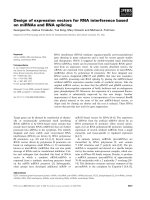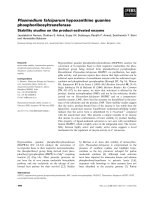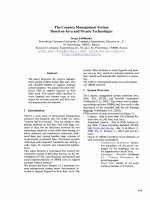STUDIES ON ENVIRONMENTAL AND APPLIED GEOMORPHOLOGY pot
Bạn đang xem bản rút gọn của tài liệu. Xem và tải ngay bản đầy đủ của tài liệu tại đây (27.9 MB, 294 trang )
STUDIES ON
ENVIRONMENTAL
AND APPLIED
GEOMORPHOLOGY
Edited by Tommaso Piacentini
and Enrico Miccadei
Studies on Environmental and Applied Geomorphology
Edited by Tommaso Piacentini and Enrico Miccadei
Published by InTech
Janeza Trdine 9, 51000 Rijeka, Croatia
Copyright © 2012 InTech
All chapters are Open Access distributed under the Creative Commons Attribution 3.0
license, which allows users to download, copy and build upon published articles even for
commercial purposes, as long as the author and publisher are properly credited, which
ensures maximum dissemination and a wider impact of our publications. After this work
has been published by InTech, authors have the right to republish it, in whole or part, in
any publication of which they are the author, and to make other personal use of the
work. Any republication, referencing or personal use of the work must explicitly identify
the original source.
As for readers, this license allows users to download, copy and build upon published
chapters even for commercial purposes, as long as the author and publisher are properly
credited, which ensures maximum dissemination and a wider impact of our publications.
Notice
Statements and opinions expressed in the chapters are these of the individual contributors
and not necessarily those of the editors or publisher. No responsibility is accepted for the
accuracy of information contained in the published chapters. The publisher assumes no
responsibility for any damage or injury to persons or property arising out of the use of any
materials, instructions, methods or ideas contained in the book.
Publishing Process Manager Silvia Vlase
Technical Editor Teodora Smiljanic
Cover Designer InTech Design Team
First published March, 2012
Printed in Croatia
A free online edition of this book is available at www.intechopen.com
Additional hard copies can be obtained from
Studies on Environmental and Applied Geomorphology, Edited by Tommaso Piacentini
and Enrico Miccadei
p. cm.
ISBN 978-953-51-0361-5
Contents
Preface IX
Chapter 1 Using Discrete Debris Accumulations
to Help Interpret Upland Glaciation of
the Younger Dryas in the British Isles 1
W. Brian Whalley
Chapter 2 Biogeomorphologic Approaches to a Study of
Hillslope Processes Using Non-Destructive Methods 21
Pavel Raška
Chapter 3 Geomorphological Instability Triggered by Heavy
Rainfall: Examples in the Abruzzi Region (Central Italy) 45
Enrico Miccadei, Tommaso Piacentini,
Francesca Daverio and Rosamaria Di Michele
Chapter 4 Environmental Changes in
Lakes Catchments as a Trigger
for Rapid Eutrophication –
A Prespa Lake Case Study 63
Svetislav S. Krstić
Chapter 5 Intervention of Human Activities
on Geomorphological Evolution of
Coastal Areas: Cases from Turkey 119
Cüneyt Baykal, Ayşen Ergin and Işıkhan Güler
Chapter 6 Spatial and Time Balancing Act: Coastal
Geomorphology in View of Integrated Coastal
Zone Management (ICZM) 141
Gülizar Özyurt and Ayşen Ergin
Chapter 7 Hydro-Geomorphic Classification and
Potential Vegetation Mapping for Upper
Mississippi River Bottomland Restoration 163
Charles H. Theiling, E. Arthur Bettis
and Mickey E. Heitmeyer
VI Contents
Chapter 8 Anthropogenic Induced Geomorphological
Change Along the Western Arabian Gulf Coast 191
Ronald A. Loughland, Khaled A. Al-Abdulkader,
Alexander Wyllie and Bruce O. Burwell
Chapter 9 Comparison of SRTM and ASTER Derived
Digital Elevation Models over Two Regions
in Ghana – Implications for Hydrological
and Environmental Modeling 219
Gerald Forkuor and Ben Maathuis
Chapter 10 From Landscape Preservation to Landscape
Governance: European Experiences with
Sustainable Development of Protected Landscapes 241
Joks Janssen and Luuk Knippenberg
Chapter 11 Introduction to Anthropogenic Geomorphology 267
Dávid Lóránt
Preface
Geomorphology is the interdisciplinary and systematic study of landforms and their
landscapes as well as the earth surface processes that create and change them
(Castiglioni, 1986; Goudie, 2004; ). The overwhelming
majority of human activities interact with the landforms that make up the surface and
near surface of terrestrial, nearshore and offshore ‘landscapes’. Understanding and
mapping geomorphology therefore can be seen as fundamental to the safe, economic
and sustainable development of the planet Earth (Alcantara-Ayala and Goudie, 2010;
Smith et al., 2011).
This branch of the science acquired its role in the natural science since the ‘800s and
developed progressively. Since the end of the ‘900s geomorphology can be included
within applied and environmental sciences and contributes to face and solve several
environmental and geological issues.
In this fields geomorphological analysis provides methods and tools for mapping of
landforms to define hazards and resources and for mapping of other phenomena
through their association with landform. It is possible to identify rates of change of
hazardous phenomena and causes of changes and hazards, to help post event surveys
of hazardous events, and to predict and model future scenarios and hazards. In this
way geomorphology contributes to monitor present changes, model future changes,
identifies vulnerable areas, and provides useful indication for mitigation strategies and
management solution of geomorphological problems, also considering feedbacks of
geomorphological change (Panizza, 1996; Alcantara-Ayala and Goudie, 2010). The base
of this work is mapping of morphometry, landforms, hazards, etc. using field surveys,
airphotos, remote sensing, GIS to produce geomorphological maps. Mapping landforms
implies mapping, and understanding the related processes (Smith et al., 2011).
Environmental and applied geomorphology supports, thereafter, a correct and
sustainable land management taking into account specific risk and resources.
This book includes several geomorphological studies up-to-date, incorporating
different disciplines and methodologies, always focused on methods, tools and
general issues of environmental and applied geomorphology. In designing the book
we considered the integration of multiple methodological fields (geomorphological
mapping, remote sensing, meteorological and climate analysis, vegetation and
X Preface
biogeomorphological investigations, geographic information systems GIS, land
management methods), study areas, countries and continents (Europe, North America,
Asia, Africa).
Particularly, in a trip from north to south and from west to east, eleven chapters are
included in this book.
In the first chapter W. B. Whalley takes an overview of the mapping problems associated
with features, other than moraines, associated glacial features. Recognising the genesis of
them is important as it may help to provide evidence for the magnitude-frequency of
cold events. Furthermore, as some features seen and mapped may be post-glacial slope
failures rather than glacial deposits, their identification and correct interpretation may be
useful for mapping slope failures in an area rather than glacial features.
P. Raška, in the second chapter, presents new non-destructive methods and techniques
used in the biogeomorphologic study of hillslope processes, particularly sheet erosion
and shallow landslides. These processes have significant impacts on landscape and
society and their research represents the fundamental issue for applied
geomorphology.
Geomorphological effects of heavy rainfall are analysed in the third chapter by
Miccadei et al., through field surveys, aerial photo analysis and inventories, mapping
the distribution of the landslides, soil erosion and flooding. The chapter highlights that
these types of methods, investigations and data are basic in applied studies for the
stabilisation and management of slopes and minor or major drainage basins, and for
general land management. These types of studies allow to define the future scenarios -
which sustainable land planning and management should be based on - supporting
the process of creating an urban plan.
The fourth chapter, by Svetislav S. Krstić, is focused mainly on environmental issues of
eutrophication in lakes’ history contributing to elucidating and/or separating the
natural processes from the anthropogenically induced ones. In this regard, under the
comprehensive River Basin Management Plan development for the Prespa Lake
catchment (Macedonia), the results of a 12 months surveillance monitoring are
presented in this chapter, in order to reveal the present ecological situation and the
past changes during the last 10 ka period.
Being that coastal zones are socially and economically important and with high
population densities, chapter five, written by Baykal et al., deals with the complex
management of these areas. It focuses on interdisciplinary approaches of integrated
coastal zone management (ICZM) as efficient actions for sustainable development and
for facing risks in coastal areas. The results coming from fuzzy coastal vulnerability
assessment model allow to discuss the role of geomorphology on vulnerability of
coastal areas. Integration of different spatial and temporal of geomorphology and
ICZM are also discussed.
Preface XI
Among simple and major questions concerning a wide variety of challenging coastal
problems, the sixth chapter by Özyurt and Ergin gives brief information on the
theoretical background of sources of sediment transport mechanisms and physical and
numerical modeling attempting to understand these mechanisms. Special emphasis is
given to the numerical modeling of shoreline changes due to longshore sediment
transport in areas where human induced activities put a pressure on the sediment
supply resources and particularly on coastal geomorphology.
There are many environmental and economic management needs that can be
addressed with ecosystem modelling, focusing not only on coastal areas but also, for
example, on fluvial landscapes. Methods and data presented by Theiling et al. in
chapter seven, concerning Upper Mississippi River, indicate how Hydro-Geomorphic
Classification and potential vegetation mapping can help estimate physical-ecological
cascades resulting from hydrologic and geomorphic alteration of large rivers, and
related restoration.
Chapter eight, by Loughland et al., identifies and quantifies changes in the coastal
ecosystems of an area that underwent a strong impact of man in the landscape, the
Arabian Gulf. The changes are documented by field survey and remote sensing. The
chapter reports the rapid change since 1967, highlights the development trends and
land use changes until 2010 within the coastal zone, and indicates areas where urgent
additional conservation actions are now required to protect the remaining natural
habitats and wildlife populations from continued impact resulting from rapid and
hastening coastal development.
In chapter nine, by Forkuor and Maathuis, the most worldwide used freely available
DEMs - the SRTM and ASTER derived DEMs - are compared and validated against a
reference DEM in two regions of Ghana. the study has revealed that SRTM is “closer”
to the Reference DEM than ASTER, although both products are useful, and has
confirmed that various surface processes can be appropriately studied when using
these global elevation data sets. This data is an excellent replacement for local 1:50 000
maps particularly in the analysis of environmental and hydrological processes.
Chapter ten, by Janssen, deals with a broad subject, contributing to the recently started
debate on sustainable development of protected areas by comparing and assessing the
different governance strategies in British, French and German protected landscapes.
Some preliminary conclusions are drawn, and some remarks are given on the future of
protected landscapes in Western Europe in a governance context.
Finally, the last chapter, by Lóránt, is a broad introduction to the Origin and
development of anthropogenic geomorphology, a new approach and practice to
investigate our physical environment. This approach came from the urgent demands
of society against geography and geomorphology, that underlined the tasks to
promote efficiently the rational utilization of natural resources and potentials, to
XII Preface
achieve an environmental management satisfying social requirements and
opportunities.
Dr. Tommaso Piacentini
Department of Engineering and Geology,
University "G. D'Annunzio" of Chieti Pescara,
Italy
Dr. Enrico Miccadei
Associated Professor of Physical Geography and Cartography,
Department of Engineering and Geology,
University "G. D'Annunzio" of Chieti Pescara,
Italy
References
Alcantara-Ayala I., Goudie A. S. (Eds.) (2010). Geomorphological Hazards and
Disaster Prevention. Cambridge University Press,
Panizza M. (1996). Environmental Geomorphology. Developments in Earth Surface
Processes, 4. Elsevier, Amsterdam.
Smith M.J., Paron P., Griffiths J.S. (2011). Geomorphological mapping, methods and
applications. Developments in Earth Surface Processes, 15. Elsevier,
Amsterdam.
Castiglioni G.B. (1986). Geomorfologia. UTET, Torino.
Goudie A. Ed. 2004. Encyclopaedia of Geomorphology. Routledge, London.
1
Using Discrete Debris Accumulations
to Help Interpret Upland Glaciation of
the Younger Dryas in the British Isles
W. Brian Whalley
Department of Geography, University of Sheffield, Sheffield,
United Kingdom
1. Introduction
With no glaciers in the British Isles in the last 10, 000 years or so, the acceptance of the
‘Glacial theory’ propounded by Agassiz and Charpentier in the Alps in the 1830-40s was late
to be accepted in the British Isles (Chorley, et al., 1973). Scientists from the British Isles had
travelled to areas with glaciers, yet even popular tourist areas such as the English Lake
District area were not considered to have been affected by glaciers until the 1870s (Oldroyd,
2002). In Scotland however, the ideas of James Croll, giving a theoretical reason for changes
in climate, were persuasive in an earlier acceptance of glacial interpretations (Oldroyd,
2002). Field mapping by the Geological Survey in Edinburgh helped to displace the ‘floating
iceberg’ and ‘diluvial’ theories, especially in the explanation of erratics (Rudwick, 2008).
Once accepted, the basic tools of mapping the former extent of glaciers, for example by the
recognition of moraines, became commonplace. More recently, aerial and satellite imagery
have made drumlins and cross-cutting depositional modes important in elucidating the
limits of the terrestrial Pleistocene glacial record (Clark et al., 2004). However, and perhaps
inevitably, interpretations of the significance of some moraines and their corresponding
glaciers has been in debate. Together with chronological methods, detailed mapping of
glacial limits and altitudes allow comparisons with climatological models and general
climatic interpretations such as the recent interpretations of the Younger Dryas in Scotland
summarised by Golledge (2010).
In this paper I take an overview of the problems associated with a variety of features, other
than moraines, associated with mapping the glacial limits (and associated climatic
conditions) in the Younger Dryas Stadial in the British Isles. It does not aim to be
comprehensive in treatment of these features in the British Isles but is concerned with the
problems of mapping and interpreting a variety of features. Recognising the genesis is
important as it may help to provide evidence for the magnitude-frequency of selected events
as well as help to distinguish between a variety of events that may produce similar-looking
landforms. Furthermore, as some features seen and mapped may be post-glacial slope
failures rather than glacial deposits, their identification and correct interpretation may be
useful for mapping slope failures in an area rather than glacial features. First however, it is
necessary to identify some terms and meanings that will be used or have been used in
mapping the Late Holocene in the uplands of the British Isles.
Studies on Environmental and Applied Geomorphology
2
2. The Younger Dryas (YD) in the British Isles and the dating of events
In the British Isles, the cold period known as the Younger Dryas Stadial (12.8 – 11.5 ka BP)
(Muscheler et al., 2008) but also, and more usually, considered to be 11 – 10 ka BP. It is also
known as the Loch Lomond Stadial after the large inland loch to the north of Glasgow. The
last stage of the Last Glacial Maximum in the British Isles is generally taken to be the
Dimlington Stadial (Rose, 1985) 26 – 13 ka BP as part of the Late Devensian Glaciation. As
such, the Younger Dryas saw a deterioration (increasingly cold and wet) period in which
glaciers advanced (or grew) again. It followed a relatively warm period known in the British
Isles as the Windermere Interstadial (= Allerød). The variability of the dating the YD may be
related to when the cooling stage started and its severity. That the YD is generally agreed to
be a world-wide phenomenon (Ivy Ochs et al., 1999) with glacier advances being seen e.g. in
the Colorado Rockies of interior USA (Menounos and Reasoner, 1997) as well as more
maritime areas such as the British Isles. It is also suggestive that the timing may not be
exactly coeval everywhere but may indicate that responses to climate change may differ, e.g.
in latitude, altitude as well as ‘continentality’ across the islands. These uncertainties need to
be taken into consideration when viewing the landforms and processes in this paper. For
example, the date of a recessional moraine of a glacier in the Alps may be known to a year
but this is highly unusual in moraine sequences as far back as the YD. Even dated trees need
to be put in context. Similarly the known maximum advances of glaciers in the Little Ice Age
(again variously defined in terms of chronology but generally taken to be 1600 – 1850 CE).
Examples from the Alps and Pyrenees as well as elsewhere provide some near present-day
analogues that help interpretation in the British Isles.
In upland areas, where the Younger Dryas glaciers may have been small and reacting to
subtle variations in a rapidly changing climate, the analysis may require careful mapping
and interpretation for specific areas. This is shown by Benn and Lucas in their
landsystems approach in NW Scotland (Benn & Lukas, 2006). They use present-day
analogues to help their interpretation much in the same way that Hauber et al. (2011) have
used Svalbard to provide periglacial analogues for Martian landforms. The use of
analogues is used generally for the interpretation of surface features in planetary geology
(Farr, 2004). This use is appropriate as periglacial and possibly permafrost features are
associated with upland regions of the British Isles in the Younger Dryas. Compilations of
processes, mechanisms and chronologies can be found in Ballantyne and Harris (1994)
and Gordon and Sutherland (1993) and other overviews have been provided in several
other volumes (Boardman, 1987; Gillen, 2003; Gordon, 2006; Gordon & Sutherland, 1993;
McKirdy et al., 2007; Wilson, 2010).
A distinction should be made be made between periglacial, that is, around a glacier and
permafrost, a thermal condition where the mean annual air temperature is assumed to be
<-2°C. So a snowbank is generally assumed to be a periglacial feature but is not glacial, ie
with the dynamics of a glacier-ice body. Neither condition is extant in the British isles at the
present day and we shall see that may produce interpretational difficulties. The term
paraglacial has been used to indicate features that are postglacial and are involved with
sediment movement (Ballantyne, 2002; 2007). It was instituted into the literature by Church
and Ryder (1972) as, materials that were produced by ‘non-glacial processes that are
conditioned by glaciation’. Ballantyne (2007) defines it as ‘the study of the ways in which
Using Discrete Debris Accumulations to Help Interpret
Upland Glaciation of the Younger Dryas in the British Isles
3
glaciated landscapes adjust to nonglacial conditions during and after deglaciation’.
However, in many cases this does not help with the interpretation as it may not be at all
clear what was glacier or snow or permafrost-related. Further discussion can be found in
Slaymaker (2009).
If there are problems in interpreting the significance of moraines this is also true of
landscape features where the ice-debris mix is of less certain origin and formative process
unclear. For example, the ice-cored moraines investigated by Østrem in Scandinavia
(Østrem, 1964) were interpreted by Barsch (1971) as being ‘rock glaciers’. This dispute
(Østrem, 1971) is still not resolved. There are several reasons for this uncertainty;
problems of observation as well as nomenclature and understanding of the geological
processes and mechanisms involved and their rates of operation. This is despite advances
of glacial theory, sedimentology and dating techniques. Additionally, researchers coming
from diverse backgrounds have tended to have different, often divergent, views about the
processes operating and therefore the interpretations. Further discussion on this will
follow below.
3. Discrete Debris Accumulations and terminology
The term Discrete Debris Accumulations (DDA) has been used to encompass a range of
features that can be mapped in the field or from aerial photographs (Whalley, 2009). It is
used here as a non-genetic and descriptive term, such that focus can be given to whatever is
under study without any preconceived notion of origin or significance. The actual
interpretation of these features is, in the British Isles, very much related to the use of
analogues. This is especially significant when the presence of ice (of some origin) is
considered and so the recognition of ice-debris features and their mechanisms is considered.
Although DDAs may be paraglacial it could be that some are fossil glacial features and not at
all modified by post YD activity. Hence, there needs to be some care in distinguishing
between periglacial, proglacial, paraglacial and permafrost in these studies.
This paper is specifically concerned with recognising the process and mechanisms of debris
accumulations rather than dating per se. In particular, the association of specific features can
be associated with climatic conditions. For example, moraines are associated with glaciers
and the size (mass balance) of the glaciers. In the British Isles there is an assumed west-east
gradient in glacier net balance, such has been found in Scandinavia (Chorlton & Lister,
1971). There are also possibilities of changes in prevailing winter storm tracks that may
influence the size of glaciers (Whalley, 2004) that have not yet been investigated for the
palaeo-conditions for the British Isles compared with suggestions for northern Scandinavia
(Bakke et al., 2005; 2008).
The traditional view of the relationship between glacier extent, mass balance and glacial
record is the linear set of boxes in Figure 1. The ‘geological record’ is usually taken as being
manifest in the simplest (or least complicated) debris accumulation associated with glaciers;
a moraine. Although the basic idea may hold, interpretation is more complicated for
periglacial features such as snowbanks and their rock debris remnants such as ‘protalus
lobes’. Is such a feature classed as periglacial, proglacial or indeed paraglacial (Slaymaker,
2007; 2009)? This problem will be considered in more detail below.
Studies on Environmental and Applied Geomorphology
4
Fig. 1. The basic controls on glaciers and their responses in the geological record; from
Whalley (2009) after Andrews (1975) and Meier (1965). The boxed sequence is embedded
within domains that ultimately affect the geological record.
4. Mapping Discrete Debris Accumulations
Despite remote sensing techniques, direct field observation is still important when process
recognition remains a problem. In this paper it is suggested that care must be used when
interpreting landforms, especially when related to their past climatic history. This is
especially important where rates of process are assumed and where similar landforms might
be produced by different processes ('equifinality' or 'form-convergence').
Weathered rock debris accumulations, whether directly deposited from a glacier or by some
creep or flow mechanism, frequently have distinct forms, to which names are given –
although the origins may be disputed. Such discrete debris accumulations can be mapped.
To interpret these forms, especially to make inferences about environmental conditions,
observations have to be placed within the context of imperfect knowledge of behaviour and
response to past environmental conditions or events. This paper suggests that caution and
more precise glacio-geomorphological investigations are required. Selected examples
illustrate such problems from present day analogues and from ice-free areas.
The geological literature has many examples of differing or changed opinions about features
– in the widest sense. For example, in the present context, Wilson (2004) now views certain
rock glaciers in Donegal (Ireland) as (paraglacial) rock slope failures. This changes the
paleo-environmental interpretation from being related to permafrost to one where
permafrost (nor glacier) were involved.
A change in climate leading to glacier mass balance change and a glacier leaving an
interpretable and dated trace (such as a moraine) is useful in a regional as well as temporal
manner. Shakesby and co-authors (Shakesby, 1997; Shakesby & Matthews, 1993; Shakesby et
al., 1987) have discussed problem related to protalus ramparts. There are different responses
according to glacier size as well as the mode of precipitation input (winter storms, summer
Using Discrete Debris Accumulations to Help Interpret
Upland Glaciation of the Younger Dryas in the British Isles
5
monsoon) and the effects of continentality as suggested above. For example, Harrison et al.
(1998) suggested that a small glacier existed in the lee of the Exmoor plateau. This was based
on their interpretation of a small moraine or protalus rampart at the foot of a small valley
head (combe/corrie/cirque). Indeed, the use of the term ‘moraine’ or ‘protalus lobe’ may
well indicate differences of interpretation. Some of these, perhaps indistinct, features, tend
to be problems of interpretation rather than mapping. Certain debris accumulations in the
English Lake District (Sissons, 1980) present problems of climatic interpretation, especially
when it is not clear what the features represent in terms of debris and ice input. Similarly,
Harrison et al. (2008) have discussed features that have generally been called 'rock glaciers'
and their environmental significance. More precise matching of formation processes and
mechanisms to environmental conditions will help to improve modelling of ice mass extents
and volumes and associated climatic environments (Gollege & Hubbard, 2005; Hubbard,
1999).
5. Debris input to glacial systems
To the basic glacial parameters of Figure 1 weathered rock debris needs to be added to the
system for there to be traces in the geological record. This complication is rarely considered;
not just a morainic marker but to consider where, when and from where the debris addition
was made. It may well have a considerable effect on the system as a whole. The total
amount may be important. Dead ice preserved at the snout of a glacier long after the debris-
free glacier has melted may give hummocky moraine or even a rock glacier form. Further,
the debris flux may have an effect upon the ice extent. For example, a glacier in equilibrium
that receives a debris input near the snout (as from a large rockfall) could produce a glacier
advance as the ablation area is reduced. The timing of debris input (at the start or end of a
glacier advance phase for example) may be significant. Some work has been done on this in
the British Isles, eg. (Ballantyne & Kirkbride, 1987). Although dating such events via
cosmogenic ratio methods is now becoming easier (Ballantyne & Stone, 2004; Ballantyne et
al., 1998) care must be taken in the temporal interpretation.
Figure 2 indicates the potential complexity here, again related to altitude, continentality and
temporal input variations. Rock debris can be added to a glacial, permafrost or periglacial
system. Unknowns include the relative and absolute amounts of ice/water and debris but
also the flux changes in time (Nakawo et al., 2000; Whalley et al., 1996). Even ‘simple’ glacial
systems may show this. For example a large rockslide on or near the snout of a glacier may
allow the snout to advance but if away from the snout the glacier may be hardly affected. In
the relatively small glacier in the British Isles however, substantial, but largely unknown,
effects may be produced.
Figure 3 illustrates possible scenarios produced by the relative additions of weathered
debris quantities to snow/ice bodies. This should not be taken to show that certain features
will form but that they are possible given the relative components at any time. For example,
the time element is not considered as part of the formative process. Some features might be
form ‘rapidly’, others take some time. For the most part process studies do not give a good
indication of the time needed to produce a feature. If the debris is lacking then there may be
no feature formed at all. However, the diagram does suggest that there is a continuum of
features and it does help guide interpretation of what is seen or mapped.
Studies on Environmental and Applied Geomorphology
6
Fig. 2. An illustration of the weathered rock debris constituent needs to be taken into
account when considering ‘glacial, proglacial, perglacial or permafrost conditions. Not only
may the debris addition be sudden (rock avalanche) or slow and continuous (scree
formation); after Whalley (2009).
A further formational aspect not shown in Figure 3 are the possible altitude-
temperature/precipitation-continentality controls (Figures 1 and 2). Thus, it is by no means
clear where the ‘best’ analogues for the YD in the British Isles should be taken. For example,
it was once thought that rock glaciers were only found in ‘continental’ mountains until
examples from Iceland were found. The answer lay in the relative amounts of debris
supplied to small glacier systems. Furthermore, Icelandic rock glaciers are found where
there is no (or only sporadic) permafrost. Hence, the inverse interpretation; relict rock
glacier = former permafrost, needs to be used carefully. This applies in fact to most of the
features here classed as DDAs
6. Rock debris production in upland British Isles
As the ideas shown in Figures 2 and 3 depend upon debris input some consideration will
now be given to the production of rock debris. At the present day, however, there is very
little active rock fall production. There are some active scree slopes (talus), as shown by the
lack of vegetation, but these are relatively uncommon.
Rockfalls (of indeterminate size) may be associated with periods of cliff instability related to
a number of possible factors. These include glacial unloading and seismic, neotectonic,
tremors associated with isostatic readjustment (e.g. Jarman, 2006) large-scale weakening of
rock buttresses caused by intense periglacial weathering; permafrost melting or a
combination of these factors. Some characteristics of these rock glaciers includes: location
within mapped Younger Dryas glacier limits, high and steeply-angled cliffs upslope of the
landform and largely unvegetated surfaces. A review of large 'felssturz' (rockfall events) in
extra-glacial areas of Austria by (Meissl, 1998) shows how significant such events may be
even today. There is compelling evidence (Whalley, 1984; Whalley et al., 1983) that near-
glacial conditions were, and are, important in the development of rockfalls and slides.
Using Discrete Debris Accumulations to Help Interpret
Upland Glaciation of the Younger Dryas in the British Isles
7
Fig. 3. A schema illustrating the relative proportions (and perhaps fluxes) of snow/ice and
rock weathering debris in a ‘glacial’ geomorphic system. From Whalley (2009).
Permafrost warming post Younger Dryas may also have had a significant part to play as has
been suggested for present-day rockfall production and (Davies et al., 2003; Whalley et al.,
1996) have shown that large debris accumulations are often associated with Little Ice Age
events. It is not yet clear how substantial and variable was the production of debris in the
Younger Dryas, although some attempts have been made (Ballantyne & Kirkbride, 1987).
More recently, Jarman (2009) and Wilson (2009) have examined rockfalls and slope failures
associated with Younger Dryas slope activity and the production of discrete debris
accumulations. What does seem to be the case is that fossil rock glaciers and protalus lobes
are relatively rare in the British Isles and Ireland compared with many mountainous regions.
This may well be a consequence of the lack of weathering or rockfalls from the Caledonide
rocks that comprise much of upland Britain (Harrison et al., 2008). It is perhaps not surprising
Studies on Environmental and Applied Geomorphology
8
that Norway, similar in a geology of hard old rocks, also seems deficient in rock glaciers and
protalus lobes. Unsurprisingly however, present-day scree formation in Norway does seem
more active than in Britain because of more severe weathering conditions.
7. Mechanical properties of ice and ice-rock mixtures
Having thus indicated the importance, yet variability of ice/water/debris fluxes within
mountain systems in the British Isles in Younger Dryas times we now need to consider what
the effects might be upon the mechanical properties of the materials produced. This has
been considered in several papers (Whalley, 2009; Whalley & Martin, 1992; Whalley & Azizi,
1994; 2003) and will not be elaborated upon here. Figure 4 illustrates graphically another
continuum, of strength or flow of ice according to the content or dispersion of rigid rock
particles.
We have to use present-day analogues and known rheological behaviour to interpret past
deposits. Unfortunately, even the present day features may be in dispute. This makes
interpretation of Younger Dryas DDAs even more problematic, hence even more to interpret
past climate from such features.
Fig. 4. This indicates both the possible mixture models likely to have been associated with
the formation of most discrete debris associations and their mechanical properties. Thus,
from the bottom left, rock slopes may fail and provide rigid blocks, perhaps amassed as
scree with air spaces. If water/ice is mixed with the particles the mass is still rigid until
there is enough ice in the mixture to allow ice deformation (Azizi and Whalley, 1995;
Whalley and Azizi, 1994).
Using Discrete Debris Accumulations to Help Interpret
Upland Glaciation of the Younger Dryas in the British Isles
9
8. Interpreting Discrete Debris Accumulations
Table 1 (after Whalley, 2009) lists the main features likely to be seen as Younger Dryas
Discrete Debris Accumulations in the uplands of the British Isles. This must, at present, be
taken as a rather rough typology. It has not proved possible to provide a key system to help
identify features. There are three reasons for this. First, the features themselves are
somewhat variable in form and location on a hillside. Secondly, the debris input location
and type needs to be taken into account (following from Figure 3). Thirdly, the
interpretation itself may change. Thus, some of the following photographs show variations
in form. The diverse papers about the origin of the Beinn Alligin ‘rockslide’ exemplifies both
the second and third reasons starting with the original description (Sissons, 1975; Whalley,
1976) and with further detailed interpretations (Ballantyne, 1987; Ballantyne & Stone, 2004;
Gordon, 1993). A clear example of a change in opinion is that by Wilson, already mentioned,
in revising his formation model of some rock glaciers in northern Ireland to be massive
rockslides. This view then casts doubt on the interpretation of the rock glacier (in the same
geology) on Islay (Dawson, 1977). This also illustrates a further difficulty, that of
terminology, a problem that has long bedevilled this area of research, especially that of rock
glaciers (Hamilton & Whalley, 1995; Martin & Whalley, 1987).
Feature name Comments on formation etc Environmental interpretation use
or caution
Blockfield * If autochthonous (in situ):
i Was it deformed by over-riding
ice sheets?
ii How old is it?
If undeformed or not removed
how is this interpreted?
Possible cosmogenic ratio
exposure data.
Use of tors related to blockfield
might be helpful.
Hummock
y
moraine*
Passive formation (ablation)
In some cases might be related to
push moraines
Various interpretations, related to
moraines, debris transport
location, ice deformation; possible
link to Østrem-type moraine
Landslide An
y
YD or post-
g
lacial event Ice probabl
y
not involved but the
resultant landform may look like
one or other of the features listed
here.
Østrem-t
y
pe
moraine
Ori
g
inall
y
, frontal debris
deposition over 'old' snowbank;
Possible confusion with:
i Push moraine
ii Rock glacier (glacier ice or
permafrost)
iii Protalus lobe
iv Hummocky moraine
Relict feature difficult to interpret
due to lack of ice and (as far as
known) a significant relict feature.
May look like a rock glacier -
which then provides possible
interpretation problems. To date,
these have not been attributed to
any feature in the British Isles.
Protalus lobe i Involvement with
glacier/snowbank ice + debris
Glacial, nival or permafrost
maintenance, length of time of
Studies on Environmental and Applied Geomorphology
10
Feature name Comments on formation etc Environmental interpretation use
or caution
input flux
ii Involvement with permafrost-
derived + ice debris input flux
preservation; datin
g
problems
possible
Protalus rampart i Debris passivel
y
over snowbank
ii Construction by small glacier
iii Might develop into rock
glacier (permafrost or glacier
related?)
Size ma
y
indicate ori
g
in of ice;
assumption that snow-derived
relates to regional snowline rather
than possible glacierisation
altitude
Push moraine * Topo
g
raphic forms ma
y
have
various origins and perhaps
associated glacier dynamics
Interpretation as
g
lacier mar
g
in
movement or permafrost-related
dynamics?
Rock
g
lacier i Glacier ori
g
i
n
ii Permafrost origin
iii Rockslide relict
iv Composite origin
v Breach of lateral moraine wall
(not known in the British Isles)
Permafrost formative conditions
or glacier; use in constructing
regional trends for glacier ice
(below regional limit) or
assumption that all rock glaciers
are of permafrost origin; Difficult
to trace if rockfall-related
Rockslide Lar
g
e, one-off event, YD or post-
glacial
Ice probably not involved but the
resultant landform may look like
one or other of the features listed
here (see also ‘landslide’).
Bergsturz also used in the
literature
Talus (scree slope) Usuall
y
unambi
g
uous; Len
g
th of
time of formation may be
considerable.
Paraglacial reactivation of old
feature possible; may grade into
other features down-slope
(protalus lobe, protalus rampart,
rock glacier)
Table 1. This table (derived from Whalley 2009), provides a summary of the main discrete
debris accumulations likely to be found in the British Isles and Ireland, other than moraines.
The features are listed alphabetically but those marked * are not referred to in this paper.
Protalus lobe is equivalent to ‘lobate rock glacier’ or ‘valley wall rock glacier’ of some
workers. A protalus ramparts is also known as ‘winter nival ridge’, ‘pronival ridge’ or
‘snow-bed feature’.
9. Some examples of Discrete Debris Accumulations in the British Isles and
possible analogues
The following illustrations illustrate some of the features in Table 1 as well as highlight
interpretational problems associated with them. Where appropriate the UK National Grid
co-ordinate system is used.
Using Discrete Debris Accumulations to Help Interpret
Upland Glaciation of the Younger Dryas in the British Isles
11
Fig. 6. Terminal area of a small glacier descending from Y Glydder, Snowdonia (SH 625727).
This may have been a debris covered section of the lower glacier or even an incipient rock
glacier.
Fig. 7. Corrie in Tröllaskagi, Northern Iceland where there has been a small glacier but very
little debris to protect the ice from melting (Whalley, 2009). The debris cover is left as an
indistinct trace after the ice has melted. A neighbouring corrie has a distinct rock glacier
feature (Whalley et al., 1995) produced by high ice fluxes but with corresponding debris
input to protect the ice.









